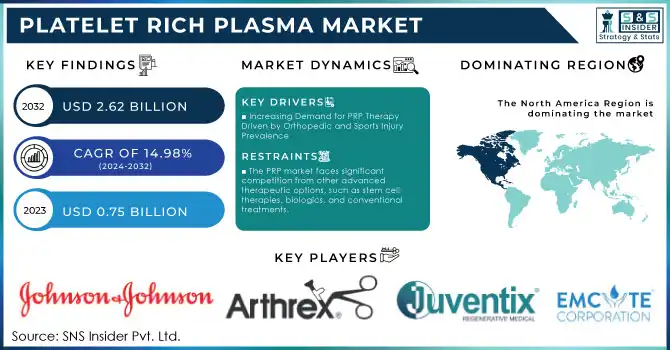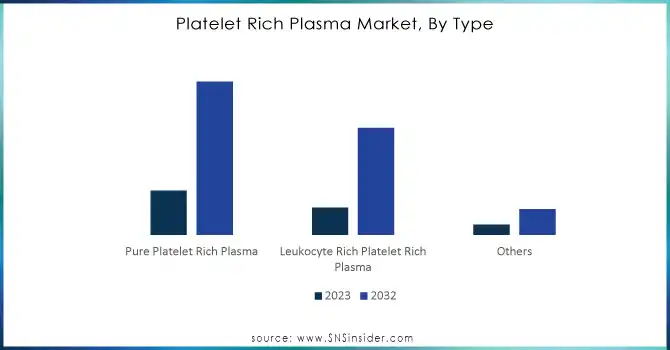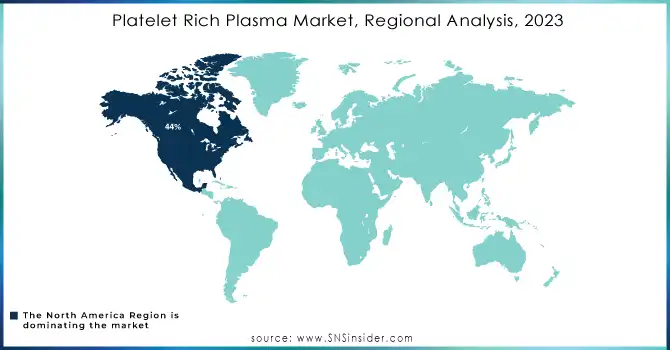Platelet Rich Plasma Market Report Scope & Overview:

To Get More Information on Platelet Rich Plasma Market - Request Sample Report
Platelet Rich Plasma Market was valued at USD 0.75 billion in 2023 and is expected to reach USD 2.62 billion by 2032, growing at a CAGR of 14.98% from 2024-2032.
The Platelet Rich Plasma market is growing rapidly, primarily driven by regenerative medicine and the broadening application of its therapies. In essence, it improves the attractiveness of minimally invasive procedures due to their ability to introduce the concept of healing and regeneration with a central role in this healing process played by PRP. Consequently, it has become increasingly used in orthopedics, dermatology, and cosmetic surgery to treat increasingly common chronic conditions such as osteoarthritis and sports injuries. In parallel, an increasing aesthetic consciousness has spurred its use in skin rejuvenation and hair restoration, adding further strength to its diversity. Furthermore, a study published in Aesthetic Plastic Surgery on January 13, 2023, found that PRP treatments significantly improve the quality of life in patients experiencing hair loss, further solidifying its role in aesthetic medicine and boosting demand for PRP-based therapies.
This rising demand is closely tied to PRP's proven efficacy and favorable safety profile, making it an attractive alternative to traditional treatments. As patients and healthcare providers seek more effective solutions, the development of advanced PRP preparation systems has been pivotal. These systems not only improve the quality of PRP products but also reduce processing times, enhancing their practicality in clinical settings. Consequently, these improvements have made PRP treatments more accessible, encouraging broader adoption across hospitals and clinics worldwide.
The PRP market presents significant growth opportunities, particularly as research uncovers new applications in cardiovascular and neurodegenerative diseases. The expansion is expected to accelerate in emerging economies, driven by increasing healthcare investments and patient awareness. To capitalize on these opportunities, industry players focus on strategic collaborations and continuous product innovation. These efforts are set to strengthen PRP's position as a cornerstone of modern therapeutic practices, ensuring its sustained market growth.
Platelet Rich Plasma Market Dynamics
DRIVERS
-
Increasing Demand for PRP Therapy Driven by Orthopedic and Sports Injury Prevalence
The escalating incidence of musculoskeletal injuries, particularly in sports and orthopedic settings, is fueling the demand for Platelet-Rich Plasma (PRP) therapy. As people engage in more physical activities, sports injuries like tendon tears, ligament strains, and joint issues have become more common, creating a growing need for effective treatment options. Additionally, musculoskeletal disorders (MSDs) contribute significantly to workplace injuries, with 40% of DART (days away from restricted or transferred) cases and 38% of DAFW (days away from work) cases occurring among females. PRP therapy, which uses the patient’s blood to promote healing, offers a minimally invasive solution that accelerates recovery and reduces downtime. Its effectiveness in treating conditions like osteoarthritis and soft tissue injuries makes it an attractive option for both athletes and individuals with chronic pain. As more healthcare professionals recognize its benefits, the use of PRP continues to expand, driving the market's growth.
-
Increase in Demand for PRP Therapy Due to Regenerative Medicine Advancements
PRP therapy is rapidly gaining traction due to its effectiveness in stimulating tissue regeneration and promoting faster healing. This has positioned PRP as a key component in regenerative medicine, particularly in sports and orthopedic fields, where it helps repair damaged tissues and accelerates recovery from injuries. Beyond musculoskeletal applications, PRP has found growing use in aesthetic treatments, including hair restoration and facial rejuvenation. Its ability to naturally rejuvenate and regenerate tissue makes it a preferred choice for individuals seeking non-surgical alternatives. As more people opt for regenerative treatments that offer minimal downtime and reduced risk, the demand for PRP therapy continues to rise, driving market growth across various medical and cosmetic sectors.
RESTRAINTS
-
The PRP market faces significant competition from other advanced therapeutic options, such as stem cell therapies, biologics, and conventional treatments.
As for stem cell therapies, these offer regenerative capabilities that could be useful in various disorders and tend to produce long-term effects as compared to the PRP. Biologics, in particular growth factors and monoclonal antibodies, are being widely taken up because they offer site-specific efficacy for targeted ailment treatment. More conservative approaches, including physical therapy, medications, and even surgery, remain the treatments of choice for diseases with an established treatment paradigm. Therefore, as alternatives continue to improve, so will the possibility of competing with a similar or superior outcome without some of the additional costs; hence, limiting the scope for PRP growth in medical practices is this competitive scenario.
Platelet Rich Plasma Market Segment Analysis
BY TYPE
The Pure Platelet Rich Plasma Segment dominated the platelet rich plasma market with the highest revenue share of about 54% in 2023. This is attributed to its proven ability to enhance healing, especially in orthopedic and aesthetic treatments. It enjoys immense popularity since it does not contain leukocytes, which decreases the risks of inflammation and hence remains in great demand by medical professionals.
The Leukocyte Rich Platelet Rich Plasma segment is expected to grow at the fastest CAGR of about 16.52% from 2024-2032. The higher concentration of white blood cells in LR-PRP enhances tissue regeneration, and hence, its use for the treatment of chronic conditions is driven by this factor. Increasing clinical evidence for the benefit, particularly for musculoskeletal treatments, fuels the fast adoption of the technology and rapid market growth.

Do You Need any Customization Research on Platelet Rich Plasma Market - Enquire Now
BY END USE
The Hospital segment dominated the platelet rich plasma market with the highest revenue share of about 53% in 2023. The major reasons for their dominance include advanced infrastructure facilities and special medical staff available to administer effective PRP therapy within hospitals. Also, its ability to provide wide services, such as orthopedic surgery and cosmetic services, contributes much to dominating the PRP market.
The Clinics segment is expected to grow at the fastest CAGR of about 16.65% from 2024-2032. Clinics are now gaining popularity in terms of PRP therapy due to their ease of access and economical treatment facilities. Growing demand for non-invasive procedures, such as aesthetic treatments and management of joint pain, is making clinics capitalize on the personalized service and quicker turnaround time that they offer, driving their fast-growing market size.
BY APPLICATION
Orthopedics was the leading segment of the platelet rich plasma market, accounting for around 44% revenue share in 2023. This is because the usage of PRP therapies has gained traction for musculoskeletal disorders such as osteoarthritis and tendon injuries. Preference for non-invasive regenerative treatments in orthopedic procedures along with the established efficacy of PRP in tissue healing have made it highly marketable.
The Cosmetology segment is poised to grow at the fastest CAGR of around 16.59% from 2024-2032. There is a growing requirement for minimally invasive cosmetic procedures, including facial rejuvenation and hair restoration. Its rising application in aesthetic medicine due to its ability to raise the levels of collagen and provide a smoother skin texture will have a positive impact on growth, fueling the market to experience strong growth over the next few years.
Platelet Rich Plasma Market Regional Outlook
North America dominated the platelet rich plasma market in 2023, accounting for a major revenue share of around 44%. This is because the region boasts of an advanced healthcare infrastructure and high patient awareness levels, which have led to the widespread adoption of PRP therapies. The strong presence of major healthcare providers and key market players, along with robust regulatory frameworks, has facilitated the integration of PRP into various medical specialties, including orthopedics, aesthetics, and sports medicine.
The Asia Pacific region is set to expand at the fastest CAGR of 16.83% during 2024-2032. Healthcare access is burgeoning, and disposable incomes are in the rising trend. Due to this, demand for PRP treatment is rising in the region. Furthermore, aesthetics, such as facial rejuvenation, and regenerative therapeutic interest for musculoskeletal conditions, increase in the region. Some emerging markets that are coming forward are Japan, South Korea, and India, due to the growing popularity of non-invasive treatments and acceptance of PRP therapies.

LATEST NEWS -
-
February 2024: Bryan Johnson's Age-Reversing Steps and Impact on PRP Use
Bryan Johnson, known for his age-reversing efforts, highlighted his use of Platelet Rich Plasma (PRP) treatments for hair restoration, boosting interest in PRP within aesthetic and regenerative medicine. -
In January 2024, RegenLab USA relocated its headquarters to a 15,792 square-foot space at 95 Greene St. in Jersey City, from the Brooklyn Army Terminal. The move aims to strengthen its research, office, and manufacturing capabilities.
KEY PLAYERS
-
Johnson & Johnson Services, Inc. (PRP Concentrate, Gelfoam)
-
Arthrex, Inc. (Angel PRP System, Arthrex Biologics)
-
EmCyte Corporation (PurePRP, EmCyte PRP)
-
Dr PRP USA LLC (Dr. PRP System, Dr. PRP Kit)
-
Juventix Regenerative Medical, LLC. (Juventix PRP, Juventix XPRP System)
-
Terumo Corporation (Terumo BCT, Terumo Autologous Platelet Rich Plasma System)
-
Zimmer Biomet (Biomet PRP, Zimmer Biomet PRP Kit)
-
Stryker (Tissue Regeneration System, Stryker PRP System)
-
Apex Biologix (ApexPRP, Apex Biologix Centrifuge)
-
Celling Biosciences, Inc. (ProGen PRP System, Glo PRP Kit)
-
Harvest Technologies Corp. (Harvest PRP, Harvest Bone Marrow Aspiration System)
-
Arteriocyte Medical Systems, Inc. (Magellan PRP, Magellan Autologous Platelet Concentrate System)
-
Cesca Therapeutics, Inc. (AutoXpress System, ThermoGenesis PRP)
-
Regen Lab SA. (Regen PRP, Regen Kit)
-
Isto Biologics (IstoBone, PRP Kit)
-
RegenOrthoSport (Regen PRP, RegenOsteo Kit)
-
Vivostat (Vivostat PRP, Vivostat System)
-
BioStem Technologies, Inc. (BioPrP, BioStem PRP Kit)
-
Lonza Group (Lonza PRP, Lonza Cell Therapy System)
-
EmCyte Corporation (EmCyte PurePRP, EmCyte PRP Kit)
-
OrthogenRX, Inc. (Prolozone, Prolozone PRP Kit)
-
Regenexx (Regenexx PRP, Regenexx Stem Cell Kit)
-
Biolife Plasma Services (Biolife PRP, Biolife Autologous PRP System)
| Report Attributes | Details |
|---|---|
| Market Size in 2023 | USD 0.75 Billion |
| Market Size by 2032 | USD 2.62 Billion |
| CAGR | CAGR of 14.98% From 2024 to 2032 |
| Base Year | 2023 |
| Forecast Period | 2024-2032 |
| Historical Data | 2020-2022 |
| Report Scope & Coverage | Market Size, Segments Analysis, Competitive Landscape, Regional Analysis, DROC & SWOT Analysis, Forecast Outlook |
| Key Segments | • By Type (Pure Platelet Rich Plasma, Leukocyte Rich Platelet Rich Plasma, Others) • By End Use (Hospitals, Clinics, Others) • By Application (Orthopedics, Neurology, Cosmetics, Wound Care, Others) |
| Regional Analysis/Coverage | North America (US, Canada, Mexico), Europe (Eastern Europe [Poland, Romania, Hungary, Turkey, Rest of Eastern Europe] Western Europe] Germany, France, UK, Italy, Spain, Netherlands, Switzerland, Austria, Rest of Western Europe]), Asia Pacific (China, India, Japan, South Korea, Vietnam, Singapore, Australia, Rest of Asia Pacific), Middle East & Africa (Middle East [UAE, Egypt, Saudi Arabia, Qatar, Rest of Middle East], Africa [Nigeria, South Africa, Rest of Africa], Latin America (Brazil, Argentina, Colombia, Rest of Latin America) |
| Company Profiles | Johnson & Johnson Services, Inc., Arthrex, Inc., EmCyte Corporation, Dr PRP USA LLC, Juventix Regenerative Medical, LLC., Terumo Corporation, Zimmer Biomet, Stryker, Apex Biologix, Celling Biosciences, Inc., Harvest Technologies Corp., Arteriocyte Medical Systems, Inc., Cesca Therapeutics, Inc., Regen Lab SA., Isto Biologics, RegenOrthoSport, Vivostat, BioStem Technologies, Inc., Lonza Group, OrthogenRX, Inc., Regenexx, Biolife Plasma Services. |
| Key Drivers | • Increasing Demand for PRP Therapy Driven by Orthopedic and Sports Injury Prevalence. • Increase in Demand for PRP Therapy Due to Regenerative Medicine Advancements |
| Restraints | • Competition from Advanced Therapies and Traditional Treatments Poses a Challenge for PRP Market Growth |

